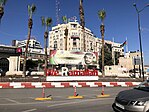
Back Ramallah Afrikaans رام الله Arabic رام الله ARZ Ramala AST Рамаллагь AV Ramallah Azerbaijani Рамаллаһ Bashkir Рамала Byelorussian Рамала BE-X-OLD Рамала Bulgarian
Ramallah | |
|---|---|
| Arabic transcription(s) | |
| • Arabic | رام الله |
| Hebrew transcription(s) | |
| • Hebrew | רמאללה |
Clockwise from top: Ramallah skyline and the central mosque, Arafat mausoleum, Our Lady of the Annunciation Church, Roman ruins, Al-Manara Square | |
Location of Ramallah within Palestine | |
| Coordinates: 31°54′N 35°12′E / 31.900°N 35.200°E | |
| Palestine grid | 168/145 |
| State | State of Palestine |
| Governorate | Ramallah and al-Bireh |
| Government | |
| • Type | City (from 1995) |
| • Head of Municipality | Issa Kassis |
| Area | |
| • Municipality type A (City) | 16,344 dunams (16.3 km2 or 6.3 sq mi) |
| Population (2017)[1] | |
| • Municipality type A (City) | 38,998 |
| • Density | 2,400/km2 (6,200/sq mi) |
| • Metro | 153,237 |
| Website | www.ramallah.ps |
Ramallah (UK: /rəˈmælə/ rə-MAL-ə,[2] US: /rəˈmɑːlə/ rə-MAH-lə;[3] Arabic: رام الله, romanized: ⓘ, lit. 'God's Height'[4][5]) is a Palestinian city in the central West Bank or Ramallah Bank, that serves as the de facto administrative capital of the State of Palestine. It is situated on the Judaean Mountains, 10 km (6 miles) north of Jerusalem, at an average elevation of 872 meters (2,861 ft) above sea level, adjacent to al-Bireh.[6]
Ramallah has buildings containing masonry from the period of Herod the Great, but no complete building predates the Crusades of the 11th century.[6] The modern city was founded during the 16th century by the Hadadeens, an Arab Christian clan descended from Ghassanids. In 1517, the city was incorporated into the Ottoman Empire, and in 1920, it became part of British Mandatory Palestine after it was captured by the United Kingdom during World War I.[6] The 1948 Arab–Israeli War saw the entire West Bank, including Ramallah, occupied and annexed by Transjordan. Ramallah was later captured by Israel in the 1967 Six-Day War. Since the 1995 Oslo Accords, Ramallah has been governed by the PNA (Palestinian National Authority) as part of Area A of the West Bank.
In recent years, Ramallah has emerged as a key political, cultural, and economic center.[7][8] It houses various Palestinian governmental bodies, including the Mukataa, the official residence of the President of the Palestinian National Authority, the Palestinian Legislative Council, and the headquarters of the Palestinian Security Services. It is also home to several museums and cultural centers, and has a notable nightlife scene. While historically a predominantly Christian town, Muslims constituted a majority of Ramallah's 38,998 residents by 2017,[9] with Christians making up a significant minority.
- ^ "Main Indicators by Type of Locality – Population, Housing and Establishments Census 2017" (PDF). Palestinian Central Bureau of Statistics (PCBS). Archived (PDF) from the original on January 28, 2021. Retrieved January 19, 2021.
- ^ "Ramallah". Collins English Dictionary. HarperCollins. Archived from the original on September 22, 2019. Retrieved September 22, 2019.
- ^ "Ramallah". The American Heritage Dictionary of the English Language (5th ed.). HarperCollins. Retrieved September 22, 2019.
- ^ "Ramallah.ps". Ramallah.ps. Archived from the original on November 5, 2011. Retrieved November 13, 2011.
- ^ Palmer 1881, p. 324
- ^ a b c "Ramallah | town, West Bank | Britannica". www.britannica.com. Archived from the original on June 27, 2022. Retrieved June 10, 2022.
- ^ "'Palestine's new bride'". The Jerusalem Post | JPost.com. August 20, 2010. Archived from the original on August 23, 2010. Retrieved June 10, 2022.
- ^ Michael T. Luongo, "Ramallah Attracts a Cosmopolitan Crowd" Archived June 8, 2010, at the Wayback Machine, June 3, 2010, The New York Times.
- ^ التعداد العام للسكان 2017 – الجهاز المركزي للإحصاء الفلسطيني Archived 2018-08-28 at the Wayback Machine
© MMXXIII Rich X Search. We shall prevail. All rights reserved. Rich X Search








